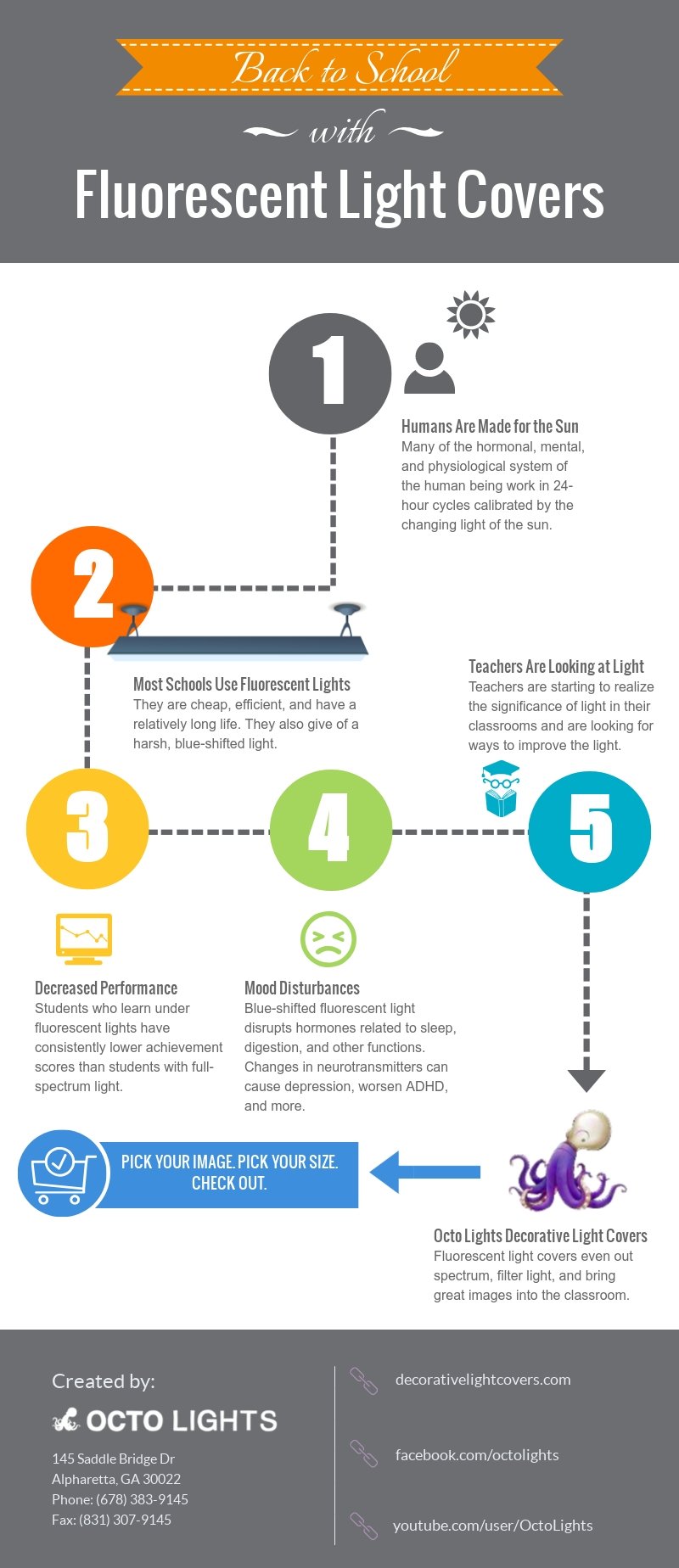
Back to School With Fluorescent Light Covers for Classrooms
5th Aug 2018
It’s almost Labor Day and summer is quickly coming to a close. In Georgia, many students have already headed back to their classrooms. While no student looks forward to the end of summer, it is possible to make school less of a drag. Many students feel like school is their least favorite place to be, and that may not be the fault of the curriculum. Schools are lit almost exclusively with fluorescent lights. When those lights aren’t properly filtered, they can create a light environment that is taxing on the body both physically and mentally. So if your students are dreading the return to school, considering brightening their trip back to school with fluorescent light covers for classrooms.

Why Light Matters
Light is all around us. Most of the time we don’t even notice it. Of course, like many things we take for granted, we notice light when there’s a problem. In a blackout, everyone notices the dark and rejoices when the lights come back. But bad lighting doesn’t just mean a blackout. Like the food we eat, the light we see can either help or hinder out physical and mental wellbeing. There is healthy light and unhealthy light, and the effects can be dramatic.
The healthiest light for humans is natural sunlight. The human body was built for the sun. Many of our internal systems, the cycles that keep up healthy, run by the sun. The daily change from dawn to daylight to dusk and back to night is like a central timepiece for the body. It calibrates numerous biological systems, from the release of hormones to the activity of neurotransmitters. There is evidence that even individual cells work on a 24-hour cycle.
Any artificial light will not have the health effects of natural sunlight. The full spectrum, naturally shifting light is ideal. But there is a vast difference in the relative healthiness of different types of artificial lighting. Artificial light that most closely resembles sunlight, including the changes throughout the day, is the healthiest. Of course, most artificial light just stays the same all the time, which can confuse your internal clock. Dim light can trigger the body to prepare for nightfall all day long. Blue light resembles midday and can trigger the wide-awake state that is most useful at that time of day. Any artificial light that extends into the night, illuminating your living space well after nightfall, will affect your body’s clock. Whatever type of light you have, it is important to be aware of its properties and how it affects your health.
The Health Effects of Fluorescent Light
Most fluorescent light, including the lights that illuminate our schools, is shifted strongly toward the blue end of the light spectrum. While white light is generally a collection of the full spectrum of visible light, the color of light from the sun actually shifts throughout the day. This is most obvious at sunrise and sunset when the angle of the sunlight hitting the atmosphere causes a dramatic red shift. But at midday, the way the sunlight hits the atmosphere tends to create a blue shift. That’s why you see blue skies on a sunny day. So when you sit under blue-shifted fluorescent lights, you are telling your body’s internal timekeeping mechanisms that it is midday. That means that it’s time to perk up and be alert. That’s great when it’s actually midday, but feeding your body that signal all day long can have dramatic effects.
The most severe effects of long-term (all day long) exposure to blue light are secondary effects. The blue light itself is not what causes the most damage. Instead, it is the disrupted sleep patterns caused by overexposure to blue light that cause the most harm. Scientists still don’t fully understand why we sleep, but we know a lot about the harmful effects of sleep deprivation.
When the body doesn’t get enough sleep, cognitive function begins the drop quickly. Simple, logical tasks take more time and become more difficult or impossible. Focus is disrupted, and the time one can focus uninterrupted is diminished. Physical functions, like reflexes, slow dramatically. The various hormones and neurotransmitters your body uses to regulate mood and mental state go haywire. Depression and anxiety are common side effects of too little sleep.
The Effect of Fluorescent Light on Students
Studies have shown that children who go to school under unfiltered fluorescent light repeatedly score lower on a wide range of tests compared to students who receive full-spectrum or natural light. On tests that check for academic ability as well as on tests that monitor mood and behavioral issues, the fluorescent light students score lower and have more challenges. Full-day exposure to blue light has been linked to worsening ADHD, higher levels of stress and anxiety, and mild to severe depression.
Students in the United States, especially high school students, already suffer from a lack of sleep. For most high school aged students, their internal clock is telling them to stay up late and sleep in. Unfortunately, while many students heed that first call, to stay of late, the second part is largely not an option. Most high school students begin classes before 8:00 a.m., and many begin well before then. The natural sleep cycle of a teenager should never be to wake that early. The result is students who come to school poorly rested and ill-prepared for their school day.
Just like adults, school-aged children are highly sensitive to changes in light. Blue shifted light from unfiltered fluorescents can trigger physical changes in body functions, usually not for the better. Stress hormones may increase. Chemicals in the body that regulate things like the processing and storing of fat are thrown off balance. Neurotransmitters responsible for mood in already fragile young minds can be totally disrupted. It is no surprise that many students dread going to school. It may be that the school environment, especially the lighting, actually does harm the mind and body of a growing child.
Fluorescent Light Covers for Classrooms
Many teachers are looking for ways to improve learning outcomes in their classrooms. It’s a vitally significant goal and one that can be hard to attain. Many teachers turn to novel interpretations of state curriculums or other gimmicks that may genuinely interest their students. However, a growing number of teachers are looking up. Staring up toward those bare or barely filtered fluorescent lights, you may experience a “light bulb” of your own. Looking up, many teachers now realize the need to change the lighting in their classrooms.
Lighting can be hard to change in a school. School policies often dictate the sorts of bulbs you can use. In addition, funding is always tight. Unless there is a continued and robust push on school administrations and governing bodies, it is unlikely that teachers alone can change the lighting in schools. However, there are some simple changes that teachers can make to modify the existing lights in their classrooms.
One of the easiest and most effective ways teachers can modify the light in their classrooms is with fluorescent light covers. Fluorescent light covers can filter the light coming from blue-shifted fluorescent lights and provide a more even spectrum. That alone can completely change the atmosphere in a room.
Images on Fluorescent Light Covers
An additional benefit of fluorescent light covers from Octo Lights is the beautiful images on the covers. Students of all ages love images of clouds and sky that seem to bring the outdoors into their classrooms. For science labs, astronomy-themed light covers bring the beauty of distant galaxies and nebulae into the lab, in all their glorious colors. Whatever mood you want in your classroom, you can probably find a fitting image. And if you can’t, you can upload your own fluorescent light cover design.
So do what many teachers have already done and find your Octo Lights fluorescent light cover today. Start making your classroom a better place to live and learn.


